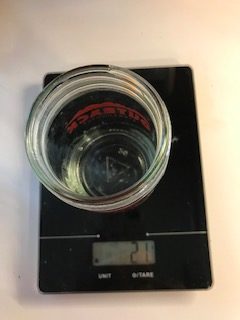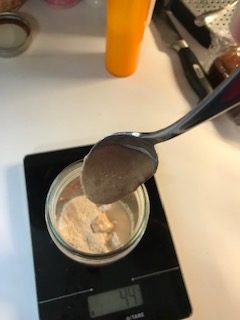The heart of sourdough bread is the starter, which is a mix of flour and water that contains wild yeasts and bacteria. These yeasts and bacteria, rather than commercial yeast, provide the leavening so the bread rises.
It’s easy to keep an established starter happy and healthy. It might seem wasteful (this can be addressed), but the starter has to be “fed”, a misnomer I think meant to confuse the novice. What really happens is that a little bit of the “before” starter is added to a mixture of flour and water to make the “after” starter. This process is repeated every three or four days at room temperature. Refrigeration will slow things down, but I’m not experienced in that – I once put the starter in the fridge when I was gone for a week. It lived. That’s all I know.
But my starter began as 100 g each of spring water and King Arthur Organic Whole Wheat flour. I just mixed that up and put it in a pint canning jar with a loose lid. Yeasts and bacteria that naturally exist in the flour were activated. Subsequent feedings increased the microorganic population, and after a week or so, the starter was ready to use.
John Rants: Many will say that the yeasts “in your environment” are what makes “your sourdough” special, but mostly it’s wheat-specific yeasts that live on the wheat plants. Kind of like nature, right? Huge variety, to be sure, but I don’t think it’s “you”. But I was a software engineer. What do I know?
Continued care of the starter consists of feeding it every three days or so. I will with clear conscience admit that I have let this slip to likely a week. Three-day-old starter is nice and bubbly, and smells yeasty and a little sour. Seven-day-old starter looks like it’s died and smells like old socks. But feed it. It’ll be fine.
My feedings occur primarily when I think of it, but fortunately I keep the starter on the kitchen counter, so it’s never too far out of sight. In a pique of experimentation, I created a starter using whole wheat flour. My prior starter was based on strong bread flour, and worked quite nicely, but I wanted more flavor. I was surprised to see that the newly-created whole wheat starter showed signs of activity after only two days. I fed it generously (100 g water / 100 g flour / teaspoon of “before” starter) once again, and after two more “normal” feedings, I was making bread.
A “normal” feeding involves weighing out equal parts water and flour (20 grams is my goal, but it’s tough to pour grams of water). I hit 21 this time (below). So I used 21 grams of flour simply to make it equal parts. And then I mixed in just a tiny bit of “before” starter. I’ll cover that loosely and set it aside for two or three days.


When it’s time to make bread I’ll build a large starter in addition to a normal one. For my bread recipe I typically need 100 g of starter, so I’ll branch off with 60 g water, 60 g whole wheat flour, and a teaspoon or so of “before” starter, and the next day that’ll be ready to make the levain. So much more “before” starter is used because there’s a lot more flour to consume, and this large starter has to be ready on time. I allow a day for this large starter to be ready.
It’s getting pretty clear I’m going to have to get one of those cool blogging cameras…

